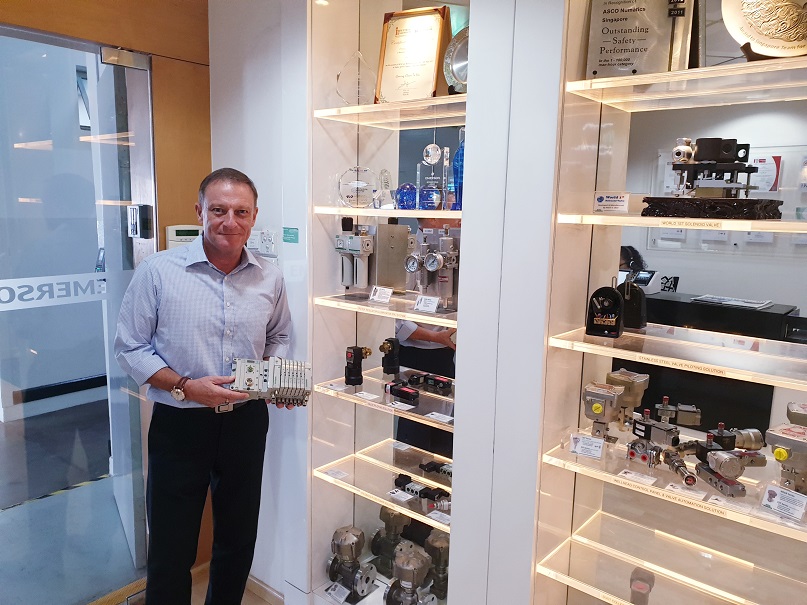

It was the last piece of the puzzle that allowed us to develop an Industrial IoT system capability for machine and factory automation applications. That’s how Philip Keating, vice president, sales, Asia Pacific, for Emerson Automation Solutions’ fluid control & pneumatics business refers to the acquisition of GE Intelligent Platforms. Announced in October 2018 and completed in February this year, the acquisition adds a significant discrete-automation range – notably, programmable logic controllers – to Emerson’s expansive offerings for process automation.
Mr Keating spoke to ARC Advisory Group in advance of this week’s Industrial Transformation Asia Pacific event (October 22-24) in Singapore, where Emerson is introducing the IIoT solution as part of a region-wide marketing initiative. He is confident the solution will see much interest and uptake from new as well as existing customers in target sectors such as machine building, automotive, life sciences, food & beverage, and water treatment.
Emerson’s fluid control & pneumatics business offers fluid control (e.g. solenoid valves) and pneumatic products (e.g. cylinders, proportional valves) under the ASCO, AVENTICS and TESCOM brands, as well as TopWorx position sensing/indication devices. Along with its Asia Pacific site in Singapore, which is separate from the main Emerson facility, regional resources include manufacturing sites in China, India, Korea and Japan and sales offices across all the major countries.

The IIoT solution, which is designed to be delivered and deployed as a package, comprises a four-layer hierarchy of Components, Connectivity, Control, and Analytics. The Components are the constituent devices of the particular fluid automation application e.g. sensors, valves and pneumatic cylinders; Connectivity denotes the IO and fieldbus communications network, which given the discrete nature of the applications, tends to be one of either Profibus, Profinet, EtherNet/IP or EtherCAT; Control is normally a PLC from the aforementioned GE Intelligent Platforms acquisition; and Analytics establishes the necessary insights into the equipment operations through dashboard graphics, which can be displayed locally on a nearby HMI or remotely via a web browser.
One phrase that Philip Keating comes back to more than once during the briefing is “meaningful data”. Because while it is not that difficult these days to get data out of machines, that data must be useful enough to lead to insights. To this end, Emerson offers “proven analytics” based on a deep understanding of the operating behaviour and failure modes of not only fluid control and pneumatics devices but also equipment like pumps and motors.
For factory automation end users, it is these IIoT insights that are extremely valuable. Given the high production rates in e.g. automotive assembly plants and F&B bottle filling lines, any unexpected equipment downtime is costly as well as disruptive to operations. Knowing in advance that a pneumatic device, for example, is approaching end-of-life enables timely replacement before its failure brings its host equipment to a halt and interrupts production. And having access to operational data such as usage spikes in compressed air or CO2 encourages intervention to limit adverse energy consumption. Meanwhile, for OEM machine builders, adopting Emerson’s IIoT solution provides additional selling features as well as reduced servicing costs.
Philip Keating revealed to ARC that Emerson is engaged with close to 100 companies in the region – both existing clients and new prospects – with its IIoT system solution. Some are at the discovery stage, interested but not sure how to start, while others are already running pilot projects. The sales process typically involves extensive discussions between Emerson experts and customers, finding out the problems they’re looking to solve, things they want to see improved, prioritising the equipment points to monitor, and providing indications of necessary investment and likely ROI.
Interestingly, Emerson is also deploying its IIoT solution internally at its own factories. At one production site in China, as well as enabling predictive maintenance capability on a valve manufacturing line, IIoT is used for quality control through measurement and dashboard-indication of critical production parameters.
In this application, the manufacturing process involves pre-lubrication of each valve before sealing, and too much or too little lube results in faulty product. So sensors are used to measure the volume and injection pressure of lube going into each valve, and production managers are quickly alerted to defective valves before an entire batch completes assembly. It is a good example of how Industrial IoT can be applied to monitor product quality as manage and improve production uptime.
Going forward, Emerson anticipates accelerating interest in its IIoT package solution for machine and factory automation and a proliferation of implementations in the Asia Pacific region as customers look to bring operational excellence to machine builders and factory automation end users.

